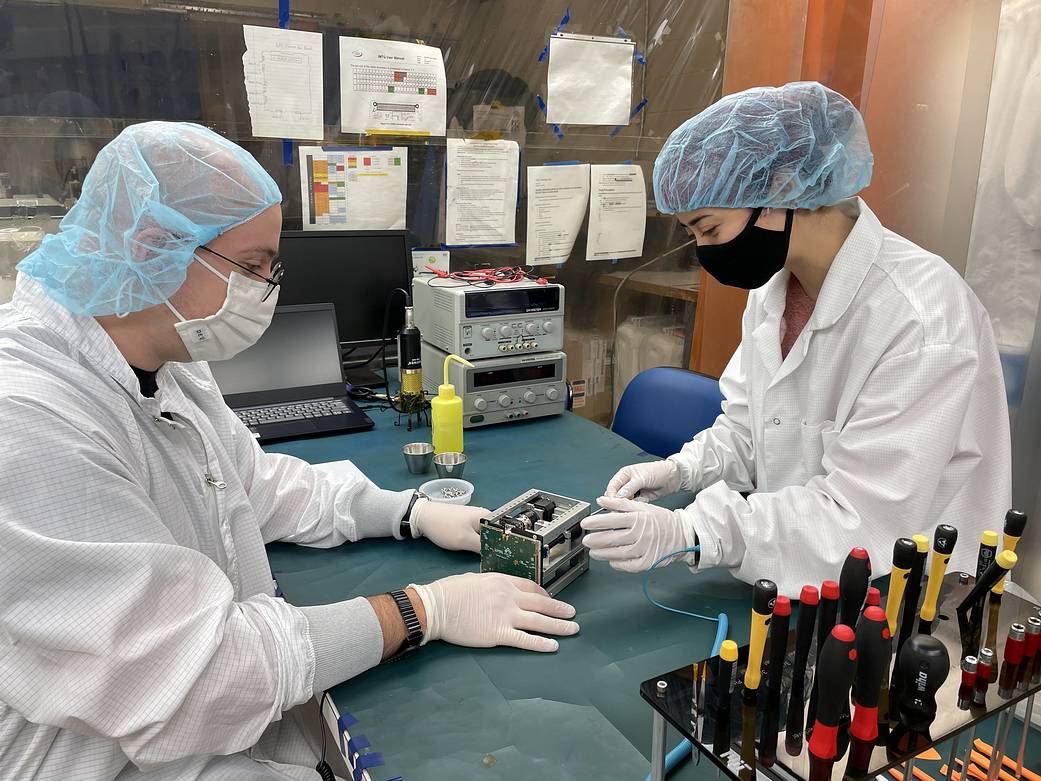Graduate students build the test assembly of the CubeSat Laser Infrared CrosslinK, or CLICK, B/C engineering development unit in a clean room at the Massachusetts Institute of Technology in Cambridge.
Image Credit: Massachusetts Institute of Technology
Teams from Massachusetts Institute of Technology (MIT) in Cambridge and University of Florida (UF) in Gainesville are currently testing components of NASA’s CubeSat Laser Infrared CrosslinK (CLICK) B/C demonstration, aiming to validate that the technology can be packaged into a CubeSat and work as expected. CLICK B/C is the second of two sequential missions designed to advance optical communications capabilities for autonomous fleets of CubeSats.
Anticipated to deploy from the International Space Station in 2023, CLICK B/C’s ground testing occurs on an engineering development unit (EDU) at MIT. The EDU is a non-flight test unit that allows the team to assess the technology’s integration and correct any issues with the system’s hardware and software prior to building the actual system that will fly into space. Lessons learned from this testing will inform the flight build of CLICK B/C’s two small spacecraft. Additionally, vibration and thermal vacuum testing of the EDU simulates the launch and space environments, allowing researchers to refine the design’s manufacturability, the system’s optical alignment, and timing between the various system components.
CLICK B/C uses invisible laser beams to demonstrate spacecraft-to-spacecraft optical communications as well as measure the relative positions of the spacecraft, also called precision ranging. Researchers are currently assessing the laser’s performance as well as the electronics’ precise timing measurements, which translate directly to the technology’s ranging capabilities. The first CLICK technology demonstration mission, CLICK A, is planned to launch in May 2022 as a risk-reduction demonstration to help improve CLICK B/C’s chances of success.
Optical technology is promising for CubeSats because it does not use as much power as conventional radio frequency communications at high data rates. Specifically, the CLICK B/C technology is a full-duplex system, meaning it can send and receive data at the same time – an important development from conventional one-way laser communications. Optical communications advancements like these can make constellations of CubeSats less costly and more efficient – the CLICK flight demonstration will build on the technology base established through other NASA missions like the Laser Communications Relay Demonstration (LCRD), which launched on Dec.7.
In addition to MIT and UF, NASA’s Small Spacecraft Technology program is partnering with small satellite manufacturer Blue Canyon Technologies (BCT) of Boulder. MIT is building and testing the EDU, while UF’s focus is on precision timing, which enables CLICK B/C’s centimeter-level ranging capability. BCT is providing the two spacecraft for the CLICK B/C mission.
NASA’s Small Spacecraft Technology program within the agency’s Space Technology Mission Directorate funds CLICK’s demonstration missions. The program is based at NASA’s Ames Research Center in California’s Silicon Valley.




























